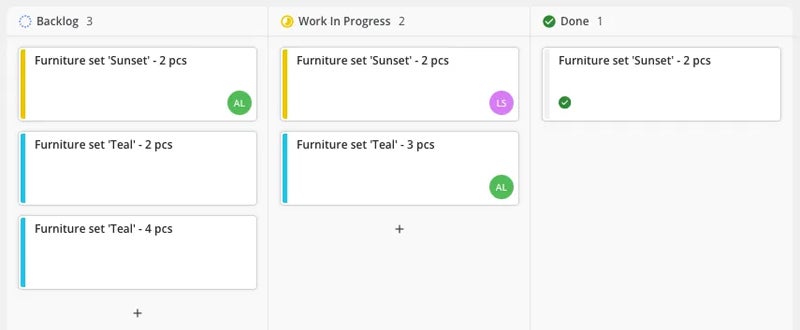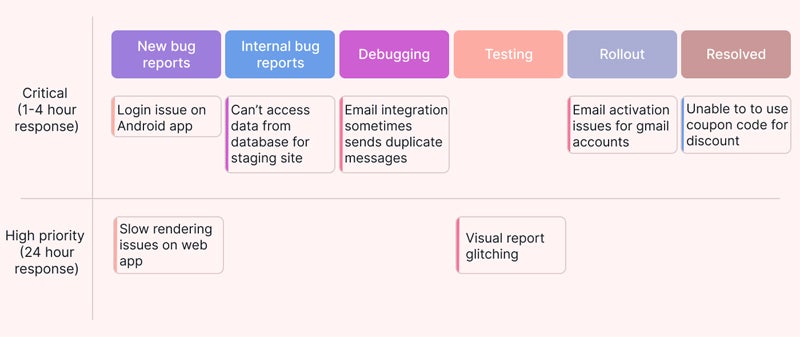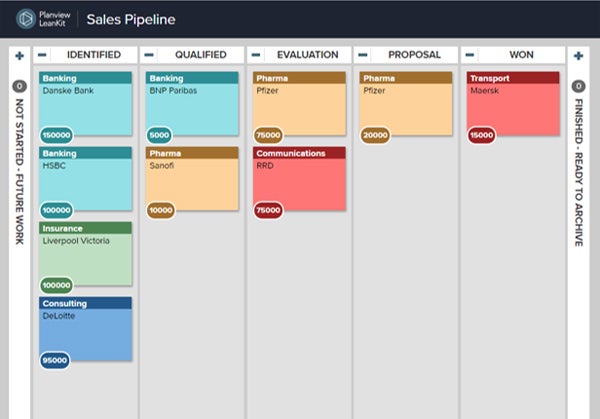If you’ve ever struggled with managing tasks or projects because you couldn’t effectively monitor progress, you’re not alone. For project managers who require a visual tracking system, a kanban board can help.
Kanban is a physical or digital visual board designed to help teams manage work and optimize the flow of tasks in a process. The goal is to improve efficiency by seeing where tasks currently sit in the pipeline and limiting work-in-progress (WIP).
Whether you work in project management, software development, or content creation, a kanban board can help improve transparency and efficiency for your tasks.
In this comprehensive guide, I’ll explain everything you need to know about kanban boards, including their history, types, best practices, and how to get started.
History of the kanban board
Kanban (看板) is a Japanese term that means “signboard,” “visual sign,” or “card.” Its origins trace back to the Toyota Production System from the 1940s, where it was developed to improve manufacturing efficiency by creating a “just-in-time” inventory system.
Since then, kanban has evolved beyond manufacturing into various industries, including software development, project management, and personal productivity.
Types of kanban boards
There are primarily two types of kanban boards: physical and digital. Both serve the same purpose but differ in how they are set up and used.
Physical kanban boards
A physical kanban board is a simple tool made from a whiteboard or cork board with sticky notes or index cards. Each card represents a task, and different columns represent stages of work. Teams can move cards across the board as tasks progress.
Physical boards are simple and effective for small teams or projects where face-to-face interaction is possible.
Digital kanban boards
The most common form of kanban board today is managed through digital platforms. Digital kanban boards are software-based solutions that teams can access remotely regardless of location.
Digital boards are handy for remote teams or individuals who want to manage tasks on the go. These tools offer features like tracking, deadlines, notifications, and integrations with other software.
Popular examples of digital kanban tools include Wrike, monday.com, and Miro.
Examples of kanban boards
A basic kanban board is primarily structured in three columns—To-Do, In Progress, and Done. However, you can modify the layout based on your project and tasks. Here are some common scenarios where kanban boards are used:
Simple kanban board
This board template shows a board with three columns outlining tasks for each stage. The Backlog column contains a pool of all tasks that need to be done at some point. It’s where ideas and upcoming tasks are captured but not yet prioritized. Once a team member picks up a task, it moves to Work in Progress. This stage makes it easy to see what’s actively being worked on.
All completed tasks are moved to the Done column. It helps track what has been accomplished and keeps morale high.

Backlog management board
This style of kanban board is useful for managing a list of requests, bugs, or feature improvements, especially in software development.
In the example provided below, the tasks move through the following columns:
- New Bug Reports: External user-reported bugs.
- Internal Bug Reports: Issues found by the team.
- Debugging: Currently being fixed.
- Testing: Quality assurance checks.
- Rollout: Release stage.
- Resolved: Completed tasks.
A setup like this ensures a clear workflow from identification to resolution.

SEE: Check out this complete guide to software development project management.
Sales pipeline board
A sales pipeline board helps sales teams visualize and manage leads as they move through the sales funnel, from capturing new prospects to closing deals. It tracks leads through stages like qualification, evaluation, and negotiations, ultimately categorizing them as won or lost.

What are the 6 rules of kanban boards?
The six rules of kanban boards, often derived from lean manufacturing principles, help maintain workflow efficiency, prevent bottlenecks, and make sure that the process stays productive.
Rule 1: Avoid sending issues to the next stage
In kanban, quality must be maintained at every stage of the process. To prevent problems downstream, defective or incomplete work should not proceed to the next phase. By doing this, each stage produces quality work and prevents defects from being passed along, leading to fewer reworks.
Rule 2: Take only what’s needed
Pull work based on actual demand and capacity. This rule prevents overproduction and minimizes unnecessary work in progress (WIP), ensuring smoother workflow.
Rule 3: Produce the exact quantity required
This works in tandem with the second rule. The goal is to produce only what is necessary to meet demand. By working based on current needs rather than forecasts, it avoids overproduction and reduces waste.
Rule 4: Level the production
The concept of leveling production is key to avoiding bottlenecks and facilitating a consistent flow of work. A kanban board helps achieve this by smoothing tasks across various stages, avoiding overburdening certain stages while others sit idle.
Rule 5: Optimize the production process
Continuous improvement is a critical aspect of kanban. The kanban board helps teams visualize inefficiencies, which allows them to fine-tune processes over time, optimizing performance and flow. Kanban metrics, such as lead time, cycle time, and throughput, are essential for teams to get a quantitative and objective workflow assessment.
Rule 6: Stabilize and rationalize the process
You can stabilize your process by following the first five rules—ensuring quality, limiting WIP, leveling production, and optimizing your process. This stability allows for a more predictable workflow, minimizing fluctuations that lead to delays.
Kanban vs scrum
Both kanban and scrum are agile methodologies. While scrum requires planning for each sprint, kanban is more about constantly reviewing and adjusting workflow to optimize productivity.
Kanban is more flexible and focuses on continuous delivery, allowing work to be done in a flow without fixed iterations. It emphasizes managing the flow of tasks and limiting WIP. Scrum works in fixed-length sprints (typically 2-4 weeks) with specific goals and deadlines. It uses timed cycles and involves more structured roles.
| Structure | ||
| Roles | ||
| Work limitations | ||
| Planning | ||
| Metrics | ||
| Changes |
Benefits of kanban boards
Kanban gives you the flexibility to gain a sustainable competitive advantage and enables your team to achieve more faster. The top advantages of kanban for your business are:
- Preventing team burnout.
- Reducing waste.
- Better visibility.
- Enhanced collaboration.
- Increased productivity.
- Continuous delivery.
- Continuous improvement.
Best practices
To get the most out of your Kanban board, I recommend following these best practices.
- Start simple: If you are new to the kanban methodology, I advise you to use three main columns—To Do, In Progress, Done—and gradually add more complexity as needed.
- Limit work in progress: Keep WIP limits low to prevent task overload and support a smooth flow of work.
- Update regularly: Keep the board updated so that it’s always a true reflection of the current status.
- Analyze flow: Routinely check for jams and areas where tasks get stuck. This can help you adjust and optimize your work.
- Embrace feedback: Hold regular team meetings to review the board, discuss challenges, and make improvements.
How to get started
Whether you opt for a physical or digital board, starting with kanban is straightforward.
- Select your preferred board type: Decide whether you want a physical board with sticky notes or a digital tool. I evaluated 13 top kanban board software options to help you determine the best digital kanban tool for you.
- Define workflow stages: Create columns that represent different stages of your process, such as To Do, In Progress, Testing, and Done.
- Add tasks: Include all your tasks on the board. Make sure each task is actionable and clearly defined.
- Set WIP limits: Don’t overload yourself or your team—limit the number of tasks you can work on at once.
- Move tasks as they progress: As tasks get worked on and completed, move them through the stages of your workflow.
- Review and improve: Periodically review the flow of tasks, identify bottlenecks, and implement changes.

